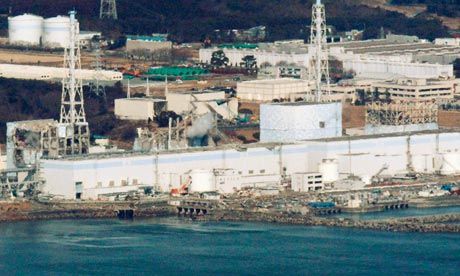
Radioactivity levels in one part of the stricken Fukushima Daiichi nuclear plant are 10m times higher than normal, Japanese officials have said, amid warnings that the operation to avert disaster at the facility could last for months..
Tests on the surface of a pool of water that has formed in the No 2 reactor revealed radioactivity of 1,000 millisieverts (mSv) per hour - four times the level deemed safe by the government. The worker carrying out the test reportedly fled before taking a second reading.
Hidehiko Nishiyama, a spokesman for Japan's nuclear and industrial safety agency (Nisa), said: "This is quite a high figure." The water was "likely to be coming from the reactor", he said.
The discovery prompted another evacuation of workers at the site, halting work to pump and store radioactive water that has built up in the turbine buildings of three of the plant's six reactors.
Evidence of dangerous contamination in the No 2 reactor emerged after three workers were exposed to high levels of radioactivity while repairing the cooling system at the No 3 reactor. Two of the men received suspected beta ray burns after stepping into water with radiation levels 10,000 times higher than normal. Reports said the workers were due to be discharged from hospital on Monday.
Modest progress was made over the weekend to remove contaminated water and step up work to cool the reactors with fresh water, rather than corrosive seawater. But Yukiya Amano, the director general of the International Atomic Energy Agency (IAEA), warned that Japan's nuclear emergency could go on for weeks, and possibly months. "This is a very serious accident by all standards," he told the New York Times. "And it is not yet over."
With just one pump currently being used to extract radioactive water, two more will be taken to the site. The US military is sending barges loaded with 500,000 gallons of fresh water to nearby Onahama Bay.
Two of the plant's six reactors are considered safe, having achieved "cool shutdown", but the remaining four have yet to be brought under control. Nisa said temperature and pressure inside all six reactors had stabilised.
The unusually high levels of radioactivity in the puddles "almost certainly" indicated that water had seeped from a reactor core, said Yukio Edano, the chief government spokesman. Edano denied the situation was deteriorating, but conceded that the myriad problems facing the power plant workers were no closer to being resolved.
"We are preventing the situation from worsening," he said. "We have restored power and pumped in fresh water, and we are making basic steps towards improvement. But there is still no room for complacency."
The deterioration in the state of the reactors is the latest in a string of complications to have hit the Fukushima operation since the plant was seriously damaged by the earthquake and tsunami along Japan's north-east coast on 11 March.
The nuclear crisis has raised fears about the safety of food in the area, while Tokyo, 150 miles to the south, experienced a brief rise in radioactivity in tap water that prompted a one-day ban on consumption by infants.
Bans have been imposed on the shipment of milk and leafy vegetables from the Fukushima region, and several countries have introduced restrictions on Japanese food imports. Last week, the US became the first country to ban the import of milk and some vegetables from contaminated areas.
Growing concern over food safety spread to the fishing industry over the weekend, when officials said seawater samples taken 20 miles off the coast of the Fukushima plant contained 1,850 times the normal level of radioactivity. Nisa said the tainted seawater posed no risk to health. "Ocean currents will disperse radiation particles and so it will be very diluted by the time it is consumed by fish and seaweed, and even more by the time they are consumed by humans," Nishiyama said. "There is no need to worry about health risks,"
Officials said on Friday they suspected one or more of the reactors had been damaged, leading to water leakages and raising the possibility of large amounts of radiation finding their way into the environment. The plant's owner and operator, Tokyo Electric Power (Tepco), has yet to determine the source of the leak.
A Nisa spokesman said the length of time workers spend inside units was being closely monitored. "It is definitely a severe environment, but the amount of time workers are allowed in there is strictly controlled so that their exposure does not exceed the limit," Minoru Ogoda said. Most of the radioactivity found in the No 2 reactor came from iodine-134., which has a half-life of 53 minutes, meaning it dissipates quickly.
The government urged the Tepco to be more transparent after it emerged that the firm knew radiation levels had risen dramatically days before the workers were injured. "Regardless of whether there was an awareness of high radioactivity in the stagnant water, there were problems in the way work was conducted," Nishiyama said.
The men were exposed to radiation of between 173 and 180 mSv, lower than the upper limit of 250 mSv per year introduced by the health ministry soon after the disaster.



As I predicted, this is many, many times worse than we have been told. They are now trying to tell us that the radiation will be dispersed in the ocean and that there is no risk? We will be eating radioactive fish but they will be "safe?"